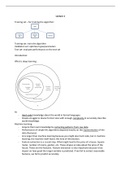Samenvatting
Deep Learning summary
- Vak
- Deep Learning
- Instelling
- Tilburg University (UVT)
Deep Learning summary of lecture slides and notes/extra information from lectures. The summary includes a lot of pictures to make content more clear.
[Meer zien]




